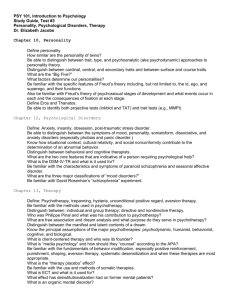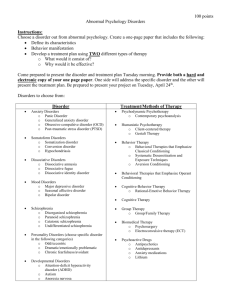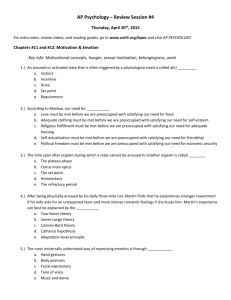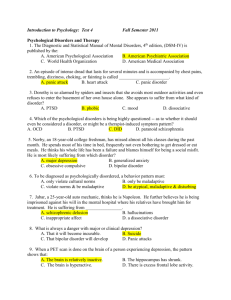Unit XI Practice Exam Answer Key – Abnormal
advertisement
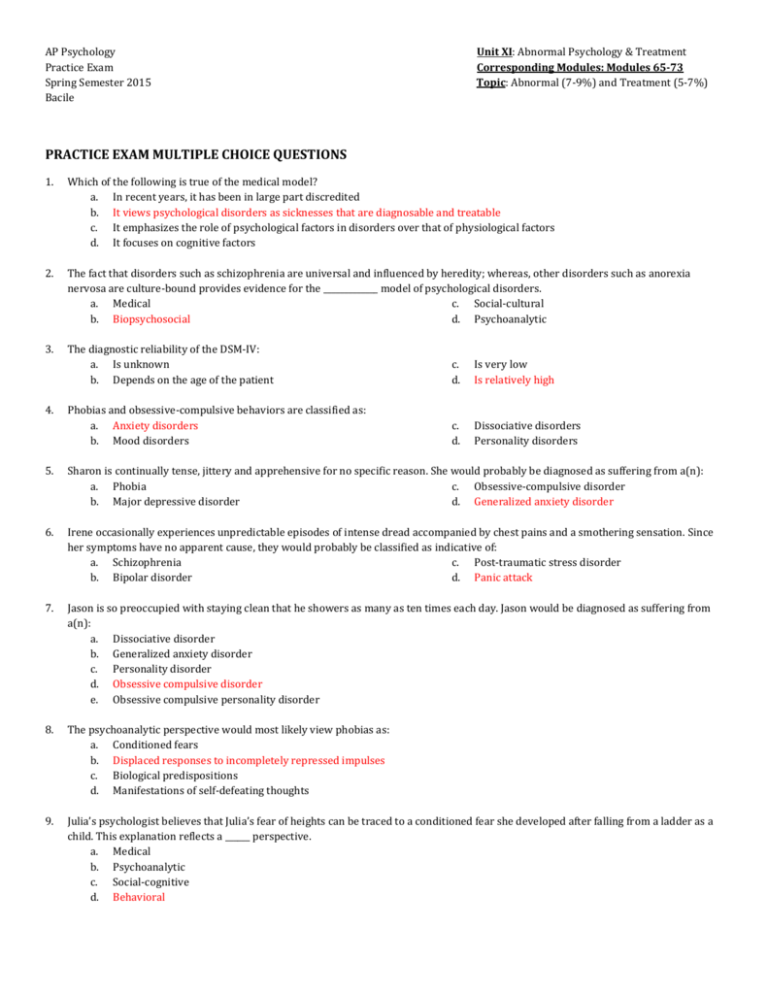
AP Psychology Practice Exam Spring Semester 2015 Bacile Unit XI: Abnormal Psychology & Treatment Corresponding Modules: Modules 65-73 Topic: Abnormal (7-9%) and Treatment (5-7%) PRACTICE EXAM MULTIPLE CHOICE QUESTIONS 1. Which of the following is true of the medical model? a. In recent years, it has been in large part discredited b. It views psychological disorders as sicknesses that are diagnosable and treatable c. It emphasizes the role of psychological factors in disorders over that of physiological factors d. It focuses on cognitive factors 2. The fact that disorders such as schizophrenia are universal and influenced by heredity; whereas, other disorders such as anorexia nervosa are culture-bound provides evidence for the _____________ model of psychological disorders. a. Medical c. Social-cultural b. Biopsychosocial d. Psychoanalytic 3. The diagnostic reliability of the DSM-IV: a. Is unknown b. Depends on the age of the patient c. d. Is very low Is relatively high Phobias and obsessive-compulsive behaviors are classified as: a. Anxiety disorders b. Mood disorders c. d. Dissociative disorders Personality disorders 4. 5. Sharon is continually tense, jittery and apprehensive for no specific reason. She would probably be diagnosed as suffering from a(n): a. Phobia c. Obsessive-compulsive disorder b. Major depressive disorder d. Generalized anxiety disorder 6. Irene occasionally experiences unpredictable episodes of intense dread accompanied by chest pains and a smothering sensation. Since her symptoms have no apparent cause, they would probably be classified as indicative of: a. Schizophrenia c. Post-traumatic stress disorder b. Bipolar disorder d. Panic attack 7. Jason is so preoccupied with staying clean that he showers as many as ten times each day. Jason would be diagnosed as suffering from a(n): a. Dissociative disorder b. Generalized anxiety disorder c. Personality disorder d. Obsessive compulsive disorder e. Obsessive compulsive personality disorder 8. The psychoanalytic perspective would most likely view phobias as: a. Conditioned fears b. Displaced responses to incompletely repressed impulses c. Biological predispositions d. Manifestations of self-defeating thoughts 9. Julia’s psychologist believes that Julia’s fear of heights can be traced to a conditioned fear she developed after falling from a ladder as a child. This explanation reflects a ______ perspective. a. Medical b. Psychoanalytic c. Social-cognitive d. Behavioral 10. Which of the following is the most pervasive of the psychological disorders? a. Depression b. Schizophrenia c. d. Bipolar disorder Generalized anxiety disorder 11. Although she escaped from war-torn Bosnia two years ago, Zhenia still has haunting memories and nightmares. Because she is so severely depressed, her therapist diagnoses her condition as: a. Dissociative identity disorder c. Schizophrenia b. Bipolar disorder d. Post-traumatic stress disorder 12. Before he can study, Rashid must arrange his books, pencils, paper and other items on his desk so that they are “just so.” The campus counselor suggests that Rashid’s compulsive behavior may help alleviate his anxiety about failing in school, which reinforces the compulsive actions. This explanation of obsessive-compulsive behavior is most consistent with which perspective? a. Behavioral c. Humanistic b. Psychoanalytic d. Social-cognitive 13. After falling from a ladder, Joseph is afraid of airplanes, although he has never flown. This demonstrates that some fears arise from: a. Observational learning c. Stimulus generalization b. Reinforcement d. Stimulus discrimination 14. Which of the following provides evidence that human fears have been subjected to the evolutionary process? a. Compulsive acts typically exaggerate behaviors that contributed to our species’ survival b. Most phobias focus on objects that our ancestors also feared c. It is easier to condition some fears than others d. All of the above provide evidence 15. Which of the following is not true concerning depression? a. Depression is more common in females than in males b. Most depressive episodes do not appear to be preceded by any particular factor or event c. Most depressive episodes last less than three months d. Most people recover from depression without professional therapy 16. In treating depression, a psychiatrist would probably prescribe a drug that would: a. Increase levels of acetylcholine c. b. Decrease levels of dopamine d. Increase levels of norepinephrine Decrease levels of serotonin 17. Dr. Jekyll, whose second personality was Mr. Hyde, had a(n) ____________ disorder. a. Anxiety c. b. Dissociative d. Mood Personality 18. As a child, Monica was severely criticized by her mother for not living up to her expectations. This criticism was always followed by a beating with a whip. As an adult, Monica is generally introverted and extremely shy. Sometimes, however, she acts more like a young child, throwing tantrums if she doesn’t get her way. At other times, she is a flirty, happy-go-lucky young lady. Most likely, Monica is suffering from: a. A phobia c. Dissociative identity disorder b. Dissociative schizophrenia d. Bipolar disorder 19. Which of the following is not a symptom of schizophrenia? a. Inappropriate emotions b. Disturbed perceptions c. d. Panic attacks Disorganized thinking 20. Hearing voices would be a(n) _____________; believing that you are Napoleon would be a(n) _____________. a. Obsession; compulsion c. Delusion; hallucination b. Compulsion; obsession d. Hallucination; delusion 21. Many psychologists believe the disorganized thoughts of people with schizophrenia result from a breakdown in: a. Selective attention b. Memory storage c. Motivation d. Memory retrieval 22. Which of the following is the effect of drugs that block dopamine receptors? a. Alleviate the symptoms associated with schizophrenia b. Alleviate the symptoms associated with depression c. Alleviate the symptoms associated with anxiety d. Alleviate the symptoms associated with obsessive-compulsive disorder 23. Janet, whose class presentation is titled “Current Views on the Causes of Schizophrenia,” concludes her talk with the statement: a. “Schizophrenia is caused by intolerable stress” b. “Schizophrenia is inherited” c. “Genes may predispose some people to react to particular experiences by developing schizophrenia” d. “As of this date, schizophrenia is completely unpredictable and its causes are unknown” 24. Research evidence links the brain abnormalities of schizophrenia to ____________ during prenatal development. a. Maternal stress b. A viral infection contracted c. Abnormal levels of certain hormones d. The weight of the unborn child e. Alcohol use 25. Bob has never been able to keep a job. He’s been in and out of jail for charges such as theft, sexual assault, and spousal abuse. Bob would most likely be diagnosed as having: a. A dissociative identity disorder c. Schizophrenia b. Major depressive d. An antisocial personality 26. An eclectic psychotherapist is one who: a. Takes a nondirective approach in helping clients solve their problems b. Views psychological disorders as usually stemming from one cause, such as biological abnormalities c. Uses one particular technique, such as psychoanalysis or counterconditioning, in treating disorders d. Uses a variety of techniques, depending on the client and the problem 27. The technique in which a person is asked to report everything that comes to his or her mind is called _____________; this technique is favored by _____________ therapists. a. Active listening; cognitive c. Free association; psychoanalytic b. Spontaneous remission; humanistic d. Systematic desensitization 28. During psychoanalysis, Jane has developed strong feelings of hatred for her therapist. The analyst interprets Jane’s behavior in terms of a ____________ of her feelings toward her father. a. Projection c. Regression b. Resistance d. Transference 29. Unlike traditional psychoanalytic therapy, interpersonal psychotherapy: a. Helps people gain insight into the roots of their problems b. Offers interpretations of patients’ feelings c. Focuses on current relationships d. Does all of the above 30. Of the following categories of psychotherapy, which is known for its nondirective nature? a. Psychoanalysis c. Behavior therapy b. Humanistic therapy d. Cognitive therapy 31. Given that Jim’s therapist attempts to help him by offering genuineness, acceptance and empathy, she is probably practicing: a. Psychoanalysis c. Behavior therapy b. Humanistic therapy d. Cognitive therapy 32. The technique in which a therapist echoes and restates what a person says in a nondirective manner is called: a. Active listening d. Meta-analysis b. Free association e. Interpretation c. Systematic desensitization 33. Which type of psychotherapy focuses on changing unwanted behaviors rather than on discovering their underlying causes? a. Behavior therapy b. Cognitive therapy c. Humanistic therapy d. Psychoanalysis e. Family therapy 34. The techniques of counterconditioning are based on the principles of: a. Observational learning b. Classical conditioning c. d. Operant conditioning Behavior modification 35. The technique of systematic desensitization is based on the premise that maladaptive symptoms are: a. A reflection of irrational thinking c. Expressions of unfulfilled wishes b. Conditioned responses d. All of the above 36. To help Sam quit smoking, his therapist blew a blast of smoke into Sam’s face each time Sam inhaled. Which technique is the therapist using? a. Exposure therapy c. Systematic desensitization b. Behavior modification d. Aversive conditioning 37. A patient in a mental hospital receives poker chips for making her bed, being punctual at meal times, and maintaining her physical appearance. The poker chips can be exchanged for privileges, such as television viewing, snacks and magazines. This is an example of the ____________ therapy technique called ____________. a. Psychodynamic; systematic desensitization c. Cognitive; token economy b. Behavior; token economy d. Humanistic; aversion therapy 38. Principles of operant conditioning underlie which of the following techniques? a. Counterconditioning d. b. Systematic desensitization e. c. Stress inoculation training Aversion therapy The token economy 39. After Darnel dropped a pass in an important football game, he became depressed and vowed to quit the team because of his athletic incompetence. The campus psychologist challenged his illogical reasoning and pointed out that Darnel’s “incompetence” had earned him an athletic scholarship. The psychologist’s response was most typical of a ______________ therapist. a. Behavior c. Client-centered b. Psychoanalytic d. Cognitive 40. Ben is a cognitive-behavior therapist. Compared to Rachel, who is a behavior therapist, Ben is more likely to: a. Base his therapy on principles of operant conditioning b. Based his therapy on principles of classical conditioning c. Address clients’ attitudes, as well as behaviors d. Focus on clients’ unconscious urges 41. Which of the following types of therapy does not belong with the others? a. Cognitive therapy b. Family therapy c. d. Self-help group Support group 42. The effectiveness of psychotherapy has been assessed both through clients’ perspectives and through controlled research studies. What have such assessments found? a. Clients’ perceptions and controlled studies alike strongly affirm the effectiveness of psychotherapy b. Whereas clients’ perceptions strongly affirm the effectiveness of psychotherapy, studies point to more modest results c. Whereas studies strongly affirm the effectiveness of psychotherapy, many clients feel dissatisfied with their progress d. Clients’ perceptions and controlled studies alike paint a very mixed picture of the effectiveness of psychotherapy 43. A person can derive benefits from psychotherapy simply by believing in it. This illustrates the importance of: a. Spontaneous remission b. The placebo effect c. The transference effect d. Interpretation 44. Your uncle wants to know which type of therapy is most effective. You should tell your uncle that: a. Psychotherapy does not work b. Behavior therapy is most effective c. Cognitive therapy is most effective d. Group therapy is best for his problem e. No one type of therapy is consistently the most successful 45. Light-exposure therapy has proven useful as a form of treatment for people suffering from: a. Bulimia c. Schizophrenia b. Seasonal affective disorder d. Dissociative identity disorder 46. Seth enters therapy to talk about some issues that have been upsetting him. The therapist prescribes some medication to help him. The therapist is most likely a: a. Psychologist c. Psychiatric social worker b. Psychiatrist d. Clinical social worker 47. Linda’s doctor prescribes medication that blocks the activity of dopamine in her nervous system. Evidently, Linda is being treated with an ______________ drug. a. Antipsychotic c. Antidepressant b. Antianxiety d. Anticonvulsive 48. Abraham’s doctor prescribes medication that increases the availability of norepinephrine in his nervous system. Evidently, Abraham is being treated with an ____________ drug. a. Antipsychotic c. Antidepressant b. Antianxiety d. Anticonvulsive 49. The type of drugs criticized for reducing symptoms without resolving underlying problems are the: a. Antianxiety drugs b. Antipsychotic drugs c. Antidepressant drugs d. Amphetamines 50. Electroconvulsive therapy is most useful in the treatment of: a. Schizophrenia b. Depression c. Personality disorders d. Anxiety disorders e. Bipolar disorder




